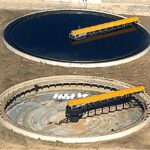The DET39 SUCTION BRIDGE FOR CIRCULAR ENCLOSURES is a specially designed piece of equipment for large diameter settlers. When operational, water enters through the lower section of the central column, rising through the pipe and exiting into the tank through the upper section enveloping the column.
With the suction bridge, the slurry is aspirated (due to the pressure differential) through pipes which drain into a circular channel attached to the bridge. Bottom scrapers working in coordination with the aspiration pipes send the settled slurry to the extraction points while the clarified water is sent to the peripheral spillways.
MAIN COMPONENTS OF THE DET39 SUCTION BRIDGE
WALKWAY
Mobile girder – one end resting on the centre pivot and the other on the drive unit which moves around the edge of the settling enclosure. There are two variants:
– Walkway in rolled steel profiles, painted or hot-galvanised, with welded handrails on either side and galvanised metal grilles on the transited area.
– Box girder walkway, built from mid-height sheet metal with an upper handrail or using sheet metal to such a height that it works as a handrail.
CENTRE PIVOT
Comprised of a base plate which serves to anchor the central pillar of the suction bridge; it includes axial ball bearings and an electric brush collector as a power source and feeder for the geared motor, and for positioning the emergency stop button. All of this is protected by a sealed lid. The walkway-centre pivot join features an articulated system which means level differences that may be caused by the movement of the drive unit opposite can be absorbed.
DRIVE UNIT
This is positioned at the end of the walkway opposite the centre pivot of the suction bridge, and comprises a geared motor with a hollow output shaft which acts directly on the shaft on the drive wheel. On the other side of the unit is the driving wheel. Both of these are Red Band-type and supported by ball bearings.
CENTRAL DEFLECTOR
Made from sheet steel, the purpose of this is to calm the water coming in through the centre pivot so that it is evenly distributed throughout the enclosure. This prevents chop which would worsen the settling process in the suction bridge.
BOTTOM SCRAPER
It consists of a sheet scraper built from carbon or stainless steel with a strip of elastomer (EPDM) on the lower section to collect the settled sludge. These scrapers are saw-toothed in shape and are attached to the suction tubes.
SUCTION TUBES
These, in turn, support the bottom scraper. These tubes aspirate the slurry from the site and move it up to the inside of the slurry gutter.
SLURRY GUTTER
Made from sheet steel, it is intended to gather the slurry aspirated and transport it by siphon to the central slurry gutter. It is suspended from the walkway using brackets. It includes regulated slurry entry gates.
SIPHON
This component moves the slurry from the slurry gutter to the circular concrete gutter flush to the central column of the suction bridge.
VACUUM PUMP
This creates the vacuum in the siphon which enables the transfer. It is installed on one side of the walkway and connects to the upper section of the siphon.
SKIMMING SCRAPER SYSTEM
This is suspended from the suction bridge walkway by means of supporting brackets and it consists of sheet metal made from carbon or stainless steel. The height may be adjusted. It can gather all floating solids and sweep them towards the Hopper, where they are discharged by the sweeper.
HOPPER FOR FLOATING PARTICLES
This is installed on the periphery of the suction bridge and is directly anchored onto the civil works. Two versions may be made: external (standardised) or submerged (height adjustable). Made from steel plate (normally stainless steel).
WEIR AND DEFLECTOR
The Weirs are a collection of sheets with triangular notches which are fixed to the concrete wall of the suction bridge to permit treated water to be ejected. The Deflectors are also rectangular sheets which are placed in front of the Weirs through the use of special supports. They stop the floating substances in the settler tank from exiting with the discharge from the Weirs.








